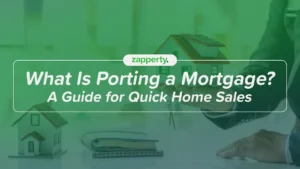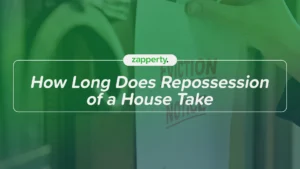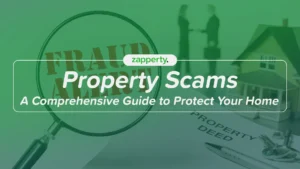If you’re a homeowner staring up at a sagging ceiling or you’ve noticed water droplets running down the wall every time it rains, you might wonder if you can sell a house with a bad roof.
The short answer to this is yes, you can. Selling a property with roof issues – even significant roof issues – is possible, though it may be more challenging. It also comes with caveats you need to be aware of to make sure you don’t run into any legal issues later on. Here, we’ll walk you through your options and how to get the best outcome.
In this article, we’ll cover how:
- Selling a house with a bad roof is possible, though it presents challenges like impacting buyer interest, sale price and mortgage approval.
- Understanding the nature of roofing issues and their effects on property value is crucial for preparing for a sale.
- You, as a seller, must choose between repairing the roof or selling the property as-is, weighing the pros and cons of each option.
- You can sell your house fast with Zapperty, even with existing roof problems.
Understanding the Impact of a Bad Roof
When it comes to selling your home, first impressions matter. Unfortunately, one of the biggest concerns a buyer is likely to have comes from a visibly damaged or poorly maintained roof. While some issues may seem cosmetic or minor, roofing problems are often a sign of more serious underlying issues that can impact the safety and value of a property.
Plus, buyers are increasingly cautious, especially when survey reports flag costly repairs or potential risks.
What Makes a Roof ‘Bad’?
A ‘bad’ roof isn’t just one with a few cracked tiles; it’s a roof that shows signs of significant wear, neglect or structural weakness. Common signs of a bad roof include:
- Leaks and water ingress: Often visible as damp patches on ceilings or walls inside the home.
- Sagging rooflines: A sign that the structure beneath may be compromised.
- Mould or moss growth: Not only unsightly, but it can be a sign of moisture retention and poor drainage.
- Missing or broken tiles/shingles: Leaves your home exposed to the elements and accelerates deterioration.
- Blocked or damaged gutters: Can lead to water overflow, damp issues and further roof strain.
These problems will be invariably picked up during home surveys and can quickly escalate into larger structural concerns. This will make many buyers think twice or request significant price reductions.
By understanding how these red flags affect buyer confidence and perceived property value, you can better prepare for your sale and avoid unwanted surprises. It’s similar to how you should declare that your home has asbestos if you know about it.
This may not be the news you want to hear, but when buyers are sinking so much money into their new home, they want to be confident that it’s going to be safe, keep them dry and not cost even more than buying a property does already.
How It Affects Your Sale
Selling a house with a bad roof comes with several challenges that can impact your timeline, buyer interest and final sale price. Unfortunately, visible roof damage will deter potential buyers. Many buyers won’t want to take on the cost and hassle of major repairs, especially if the issues are noticeable during viewings or flagged early on.
Mortgage approval can also become tricky. Lenders will usually reject applications for properties with significant roofing problems, classifying them as high risk. If a buyer’s survey highlights roof defects, their mortgage may be declined, which forces them to pull out of the deal or renegotiate at a much lower price. This then risks you losing your onward purchase, if you’re at that stage.
Another consequence is a drop in valuation. Depending on the severity of the damage, roof problems can reduce a home’s market value by as much as 50%. And there are very few people who can afford to take a financial hit as big as that.
Roofing issues are almost always flagged in building surveys. These major red flags often trigger additional inspections, like damp surveys, which lead to further delays or complications. For buyers, this means uncertainty, leading to hesitation or having to walk away altogether.
Options for Sellers
If your property has a bad roof, you essentially have two main choices: fix the problem before selling or sell the home in its current condition. Each option comes with its own pros and cons, as well as implications for price, timeline and buyer interest. Here’s a breakdown to help you decide what’s right for your situation:
Repair or Replace the Roof First
Pros:
- Broadens the appeal of your property: A repaired or new roof removes one of the biggest red flags for buyers, making the property more appealing to families, first-time buyers and anyone needing a mortgage.
- Improves chances of full market value: Homes in good structural condition can ask for higher prices and are more likely to achieve or even exceed their asking price in competitive markets.
- Makes the home mortgageable: Fixing the roof ensures the property passes lender requirements, preventing mortgage refusals and fall-throughs during the survey stage.
Cons:
- Repairs can cost between £4,000 and £19,000 for a typical family home: Depending on the size of the home and extent of the damage, costs can vary significantly and may require upfront payment before listing.
- May not deliver a full return on investment if the local market is slow: In some areas, particularly where demand is low or prices are falling, the added value from a new roof may not fully offset the expense.
Sell ‘As-Is’
To open-market buyers:
You can still list your home through an estate agent, but you’ll need to be completely honest about the roof issues. Pricing must reflect the cost of repairs, and you should absolutely expect negotiations from buyers and delays during the survey process.
To cash buyers/investors:
These buyers typically don’t require mortgages and are used to purchasing properties that may require a little extra TLC. The process is faster, often completing within a few weeks, but offers will generally be below market value to account for the necessary repairs and profit margin.
Via auction:
Selling at auction can be a quick route, as sales are legally binding once the gavel falls, but the price is less predictable. Many auction buyers are developers or investors looking for properties they can renovate and resell, so expect offers to reflect the investment needed.
Step-by-Step Guide for Selling A House with a Bad Roof
Selling a property with roof issues may be tricky, but it’s far from impossible. Whether you choose to repair the roof or sell the home as-is, taking the right steps can help you avoid delays, attract serious buyers and reduce the legal and financial risks. Here’s a step-by-step guide to help you through the process:
1. Get a Professional Roof Survey
Before listing your home, arrange for a qualified roofing contractor or chartered surveyor to carry out a detailed inspection. This report will outline the exact condition of the roof, estimated costs of repair or replacement and any associated structural concerns. Not only does this help you make informed decisions as a seller, but it also provides transparency for buyers and strengthens your credibility.
A roof survey is an additional cost – somewhere in the region of £200 – but it’s absolutely worth it for the sake of openness and attracting only serious buyers.
2. Disclose the Damage
UK property law requires sellers to disclose any known defects, including roof damage. Failing to do so can result in legal claims or compensation demands post-sale. Be upfront about the issues and include the roof survey report in your property’s information pack. This builds trust with buyers and can help pre-empt objections during the negotiation stage.
3. Decide on a Selling Route
Choose the selling method that aligns best with your budget, timeline and willingness to negotiate:
- Repair and sell via estate agent: Make the home move-in ready and aim for full market value. Ideal if you want to maximise your return and have time for repairs.
- Sell as-is with a discount: Set a realistic price that reflects the roof condition. Be prepared for more back-and-forth with buyers and a potentially longer time on the market.
- Sell to a cash buyer or via auction: Quick, hassle-free option with no need for repairs or surveys. But, expect offers below market value.
4. Price Smartly
Use recent sales data and local property listings to benchmark your price. Then adjust based on the roof survey findings and the estimated repair costs. If you’ve chosen not to fix the roof, be transparent about the price reduction in your listing. An experienced estate agent can help balance realism with negotiation room.
5. Market Effectively
Even with roof issues, your property still has selling points. Highlight what’s great about the property, like a large garden, potential for extension, good transport links or school catchment areas. If you’re selling as-is, use investor-friendly language like ‘renovation project,’ or ‘great opportunity for developers.’ Good marketing can attract the right kind of buyer, whether that’s a homeowner or an investor.
Comparing Selling Routes
| Route | Time to sell | Price achieved | Buyer pool | Mortgage issues |
| Estate agent | Weeks to months | Near full market | Broad (inc. mortgages) | May need roof repair |
| Cash buyer | Potentially just days | ~10% discount | Investors and cash buyers | No mortgage required |
| Auction | Weeks | Uncertain | Developers and investors | Usually cash buyers |
UK-Specific Legal & Regulatory Notes
When selling a property in the UK (especially one with known issues like roof damage), there are specific legal obligations and compliance rules you need to follow. These aren’t just best practices; they’re legal requirements designed to protect both you, the seller, and your buyer. If you don’t meet them, it can delay the sale and even risk legal claims after completion. Below are key points to be aware of as you prepare to put your home on the market:
- EPC Certificate: You must provide an EPC (Energy Performance Certificate) within 7 days of listing.
- Disclosure: Estate agents must disclose major repairs like roofing issues flagged in a survey.
- Legal duty: Failing to disclose major defects can result in legal action from buyers after the sale.
To Sell or Not to Sell…
So, can you sell a house with a bad roof? Absolutely. But it requires planning and the willingness to be completely transparent. You shouldn’t risk pretending like you didn’t know there were issues with the roof, as it might come back to bite you down the line.
Key takeaways:
- Conducting a professional roof survey and disclosing all issues to potential buyers is essential to avoid legal complications.
- Selecting the right selling route, whether repairing and selling at market value or selling as-is, affects timeline and pricing.
- Compliance with UK legal requirements, such as EPC certification and full disclosure, is mandatory to ensure a smooth sale process and avoid future claims.
Whether you choose to repair the roof or sell as-is, make sure to:
- Get a professional roof survey
- Be open and honest with buyers
- Choose the best route based on your finances and timeframe
Need help deciding? Zapperty buys any home, in any condition, including properties with roof problems. Reach out to us today for a no-obligation offer.
FAQ
Can I sell my house with a leaking roof?
Yes. Leaks affect the sale price and mortgageability, but many buyers (especially cash buyers) will still consider it.
Will I get full market value?
Unlikely. Expect to take a 5–50% hit depending on the extent of the damage.
Should I repair before selling?
Depends on your budget and urgency. Repairs improve sale value but come with costs.
Can cash buyers help?
Yes. They buy fast and accept homes in as-is condition. Ideal for sellers who want a hassle-free sale.
What if the buyer can’t get a mortgage?
You may need to lower your asking price or work with a cash buyer. Disclose issues early to avoid delays.




